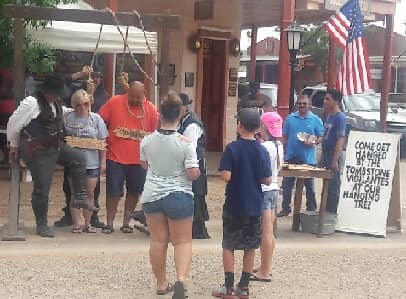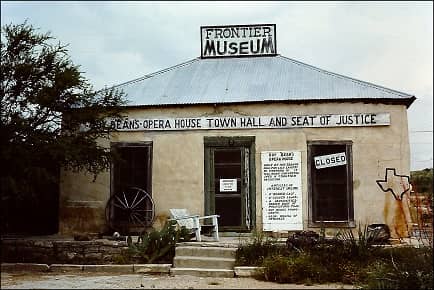The legal definition of vigilante justice is when a person or a group of people act to assert the rule of law, but they don’t have the legal right to do that. It can also mean a general state of lawlessness and/or confusion, when a variety of people or groups are claiming the power to enforce laws in the area.1 Key word there is lawlessness, as again there is no legal claim to enforce laws that way.
In Tombstone Arizona – there are two types of Vigilante Justice! But they are both very good types! Because they’re here in town for visitors to have fun and entertainment. They’re here providing a different type of Vigilante Justice to raise funds for excellent causes. Let’s find out more about these fine groups.
- In Town Since 1946, a 501c-3 charity2 – it’s the Tombstone Vigilantes>
- Founded in 1957, promoting vintage fashion & supporting causes3 – the Tombstone Vigilettes>
- What about American 1800s historical Vigilante Justice? Called Frontier Justice>
Tombstone Vigilantes
Vigilante justice for this group involves volunteering to entertain visitors to Tombstone Arizona. But also to generate funding for worthy causes. They are a 501c3 organization, gathering tax-deductible donations for a variety of organizations. They’ve supported many Tombstone affiliated groups: the Tombstone Fire Dept., Schieffelin Hall International Players (S.H.I.P.), Summer Recreation Program, Tombstone Small Animal Shelter, Seniors Meals on Wheels, Tombstone Food Bank, Renaissance Program, Friends of the Library, Friends of the Courthouse, Tombstone Restoration Commission, Tombstone High School, Walter J Meyer Middle School, Adopt a Family for Christmas, City of Tombstone Schieffelin Hall Restoration, Arizona Western Heritage Foundation, etc.

History of the Tombstone Vigilantes
This group founded for a very different type of vigilante justice in 1946. Then they incorporated in 1954 to be a 501c3 organization to focus on charitable works. Yet they still hold claim to being the longest, continuing reenactment operation in the Southwestern United States.
From their origin in 1946, their aim was promotion of Tombstone’s history. By keeping that in the memories thoughts of its citizens and visitors by reenactment of events from the Old West. Their members have always been giving volunteers, donating their own time.
Their goals are always two-fold:
- Making an entertaining history of Tombstone Arizona, to keep the towns historical focus alive
- In doing this entertainment via a variety of methods & venues, raising funds for deserving causes in need
Tombstone Vigilantes Justice
The Tombstone Vigilantes view justice as supporting other groups, while they entertain. They raise money generously contributing to so many good causes. All their members give willingly of their free time, having fun delighting visitors to Tombstone. But in doing so, their altruistic motives are to help others. That’s vigilante justice for them!
Where can you find them?
- The Second & Fourth Sundays of each month they’ll appear on Allen Street in Tombstone
- Conducting “fake Visitor hangings”
- Presenting Old West reenactments
- At Tombstone’s Special Events Days, like Wyatt Earp Days and Helldorado they’re definitely there, but especially featured at those they sponsor:
- Vigilante Days – Of course they’re there for their vigilante justice Namesake in February>
- Showdown in Tombstone is one they are now hosting – see them there Labor Day Weekend>
- They appear in festival and holiday parades in Arizona, including the Tombstone Christmas Parade, the Rex Allen Days Parade in Willcox, the Douglas Festival of Lights Parade and the Patagonia 4th of July Parade.
- They help the Fort Huachuca Arizona Army soldiers’ Christmas season Parade of Homes
- They boil & color eggs to host the Tombstone Easter Egg Hunt – rolling over 2000 eggs, giving out more than 100 toys to kids attending
- They’ve been in places giving their version of vigilante justice, via long distance – or vicariously, if you will:
- They’ve helped U.S. troops by sending supplies, for example sending personal care items to those in Iraq & Afghanistan
- They’ve helped with emergent situations, for example sent donations to help with those in need because of the 1995 Oklahoma City bombing, the 2001 World Trade Center attack, & the 2005 Hurricane Katrina disaster
Joining the Tombstone Vigilantes
The Tombstone Vigilantes hold their general meetings on the second Thursday of each month. If you want the Vigilantes to consider you as a member, they ask you fill out an application. Then you must present it to any member who is in good standing. When you do this it must be during one of their Sunday shows, or at one of the Event Weekends in Tombstone, or at a general meeting at the Vigilante Hall at 22 East Allen Street.
Do you wonder what they’ll want to know about you to join?
- Employer & occupation
- Current & 1 Prior residence
- Two references besides your two Tombstone Vigilante Sponsors
- Eleven questions to answer Yes or No – referencing if you’ve had types of felony or misdemeanors, imprisonment, restraining order, are mentally stable (or not), are drug-addicted, were dishonorably discharged, are illegally in the U.S. or renounced U.S. citizenship, or barred from firearm carry.
You can get that application, and see further detail. All the Info You Need Here>
Tombstone Vigilettes
This unique vigilante justice group has a goal and a function they plan for monthly when they meet in the Vigilante Hall. In their preparations they bear in mind certain intentions:
- Publicizing the city of Tombstone Arizona for its progress and improvement
- Elevate the general interest in the historical value of Tombstone AZ, with promotional activities
- The creation and portrayal of Tombstone’s Old West days through reenactments during Special Events in town
- To advocate and further the knowledge of women’s historical role in the Old West, plus their clothing styles (along with creating their own), focusing on the years from 1879 to 1915
The Tombstone Vigilettes method of vigilante justice is quite genteel. When founded in 1957 its purpose was for boosting enthusiasm for women’s clothing styles in the Victorian and Edwardian ages. They intended to concentrate on Tombstone’s booming Silver Mining days from 1879 – 1915. Their interest was in perpetuating those fashions.
The organization was founded on June 18, 1957. The founding members were Jean Nuttall, Polly Stark, Anita Whitaker, Ruby Creed, Stella Gray, JoAnne Whitaker and Mary Wilson.
Vigilante Justice – Vigilettes Style
Today the Tombstone Vigilettes are organized as a 501c3, a non-profit charitable organization. This group of ladies depicts women of Tombstone Arizona from 1879 through 1915 in what they call, as their motto: “Have Petticoats, Will Travel.”
The women can be called on to be present at group or club meetings, church organizations, senior living homes, historical events, etc. They deliver an informational production to showcase the fashions of their historic time-frame. Their presentation is a vignette of The Women of Tombstone, Arizona, from 1879 to 1915.
Their educational program of these fashions shows is an expanded version of those that they perform regularly on the streets of Tombstone Arizona. In Tombstone, they hold fashion shows on the 2nd, 4th & 5th Sundays of each month. They begin at 12:30 pm along Allen Street.

The fashions you’ll observe at these shows are very particular, since they’re not only to entertain, but these women are demonstrating their own style of Vigilante Justice by education! They’re fashionistas of the years 1879 to 1915, and adhere to strict guidelines for creating their styles:
- The clothes they wear are either replicas or actual vintage clothing
- The items must be made from materials, notions and fabrics truly legitimate to that referenced time-frame
- Thus no Velcro, no zippers, no polyester involved
These women of the Tombstone Vigilettes present their fashion show to entertain – yes! But also to educate the public by personifying the outstanding, pioneering women of the historic town to Tombstone. Showing these brave, hardy women as they truly were in the Victorian and Edwardian eras.
Some of the organizations they support with their fund-raising efforts are the Old Firehouse Senior Center, Tombstone Foodbank, Tombstone Small Animal Shelter, and Tombstone Sacred Heart Thrift Store.
Tombstone Vigilettes Membership
Come join us!
If you’d like to consider joining the Tombstone Vigilettes, here are the qualifications for membership:
- You must be a female, 21 years of age or older
- Reside in Cochise County or a contiguous County for at lease 90 days
- Be sponsored by two active or Lifetime members – there will be an induction process during which you are considered a prospective member
- If you’d want to participate, but don’t meet above regular membership qualifications – you may be sponsored as an Associate Member
- For further questions, or particulars on how to apply, email them: [email protected]
Once you are a Member, here is what you’d need to know:
- Yearly dues for membership are $12.00 per year.
- Meetings are held on the 1st Friday of each month at 7 pm. Located in the Tombstone Vigilante’s Hall on Allen Street.
Frontier Justice
Old West Vigilante Justice has often been referred to as Frontier Justice. It is defined as extralegal law enforcement, particularly in areas lacking any, or adequate or well-trained law officers.
To look at its beginnings in the United States, it helps to look at law development here, originally based on English common law. Self defense in that system is a last resort. The first priority is the “duty to retreat” or get away from the situation if at all possible. Proof must be had for absolutely no other choice than killing, to be absolved from murder in a self-defense claim.4
This carried over to the new world of America, at first. But with Westward expansion in the 1800s, courts began taking a different view of self-defense. The frontier life brought daily different dangers. Pioneers took many risks in areas that had no legal systems. Bounty Hunters brought a different mode of vigilante justice into the equation, as well. State Supreme courts began supporting the concept of self-defense, the precedent set in 1865 with Wild Bill Hickok.
With opinions declaring Americans didn’t need to retreat when faced with a threat to their life. The U.S. Supreme Court officially ruled on that in 1921, stating there is “no duty to retreat.”4
Look at some types of the vigilante justice systems considered frontier justice of the Wild West days:
- Lynchings on a hanging tree were typical of frontier justice sentences
- John Heath, convicted of organizing the Bisbee Massacre was lynched in Tombstone, but he was hung from a telegraph pole on February 22, 1884
- Helena Montana grew a quite productive Hanging Tree, a ponderosa pine – from 1865 to 1870, at a minimum, ten men swung from its limbs6

- Those types of sentences were sometimes carried out by a vigilante justice mob
- On June 1, 1894 in Colfax Oregon, George Parker & Ed Hill were pulled from their jail cells by armed men who broke in. One convicted of assault (the victim had died), the other awaiting murder trial. They were hung from the jailhouse balcony by frontier vigilante justice!5
- A crooked judge of those times could also mete out what is considered frontier justice
- Judge Roy Bean was an infamous Texas judge of this sort
- Gun-fighting was also considered a form of frontier justice
- The prime one in Tombstone Arizona was the Gunfight at the O.K. Corral
- Another famous (a news magazine drawing portrayed the event in 1867 – viewed above) one was over insults via gambling money owed and a pocket watch, on July 21, 1865. It occurred between Wild Bill Hickok and Davis Tutt in Springfield Missouri’s town square. The judge’s ruling set a precedent for self defense cases4

- Then there were the vigilante justice teams gathered into a posse to track down victims, then often shot on sight in this form of frontier justice
- Think of Wyatt Earp’s Vendetta Ride
References
1 Legal Information Institute (n.d.). Vigilante justice. Cornell Law School. Retrieved from law.cornell.edu/wex/vigilante_justice
2 Tombstone Vigilantes (2018). About us. Circa 2018. Tombstone Vigilantes Inc. Retrieved from tombstonevigilantes.com/about-us
3 Tombstone Vigilettes (n.d.) About. @TombstoneVigilettesTombstoneAZ. Retrieved from facebook.com/pg/Tombstone.VigilettesTombstoneAZ/about/?ref=page_internal
4 Mullins, J. (1994, May/June). To stand your ground. American Cowboy, p. 36-37. William E Bales: Wichita, Kansas.
5 Lambeth, R.M. (n.d.) Frontier violence in Colfax: The courthouse lynchings. Spokane Historical. Retrieved from spokanehistorical.org/items/show/434.
6 Kidston, M.J. (2010, June 13). The tree of death. Independent Record. Helena MT. Retrieved from helenair.com/lifestyles/article_17972c78-76a5-11df-aea1-001cc4c002e0.html


